



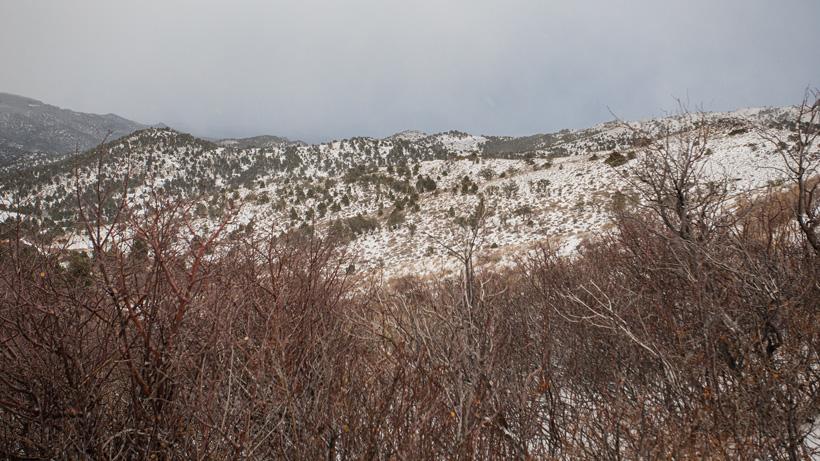
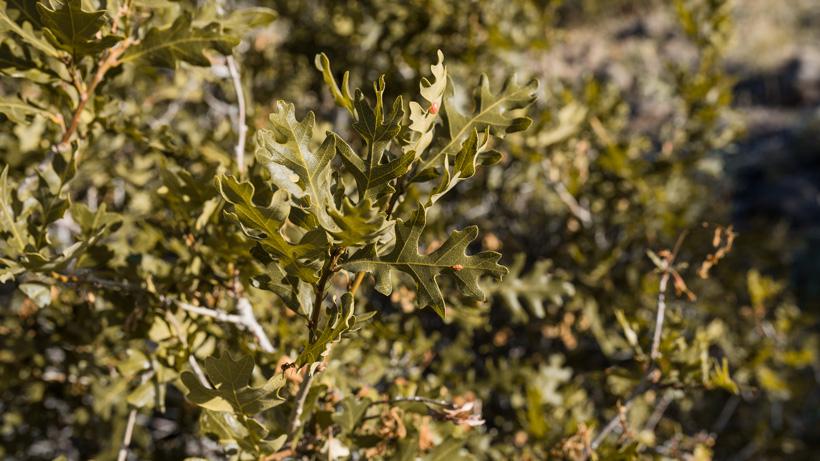
A closeup photo of oak brush.
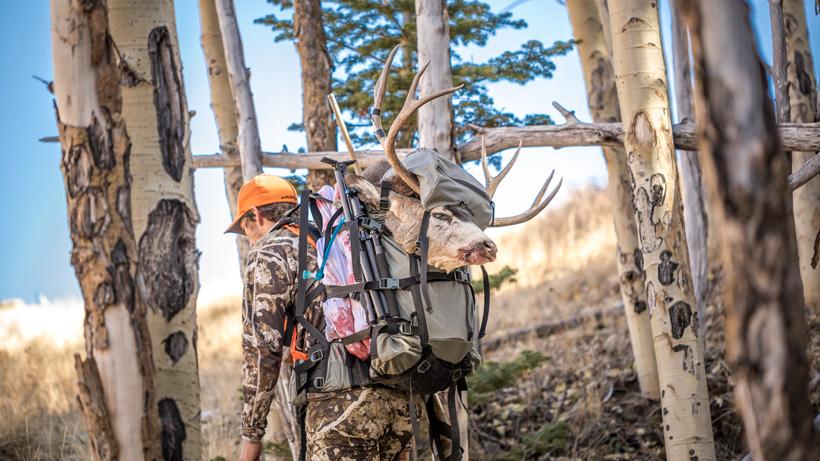
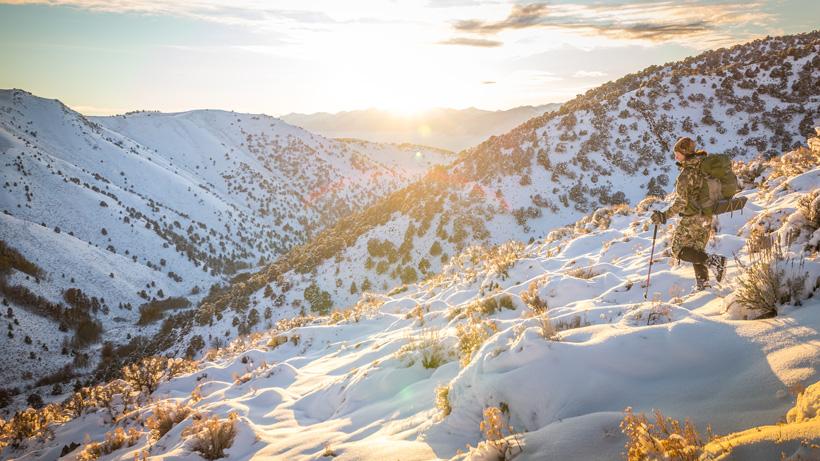
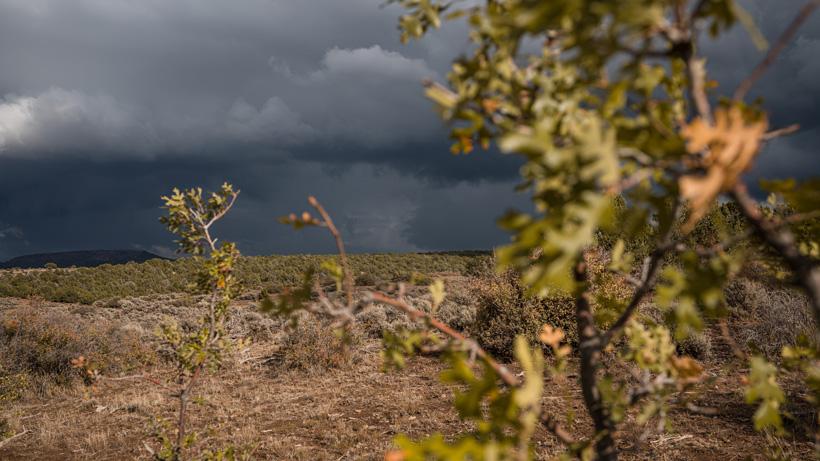
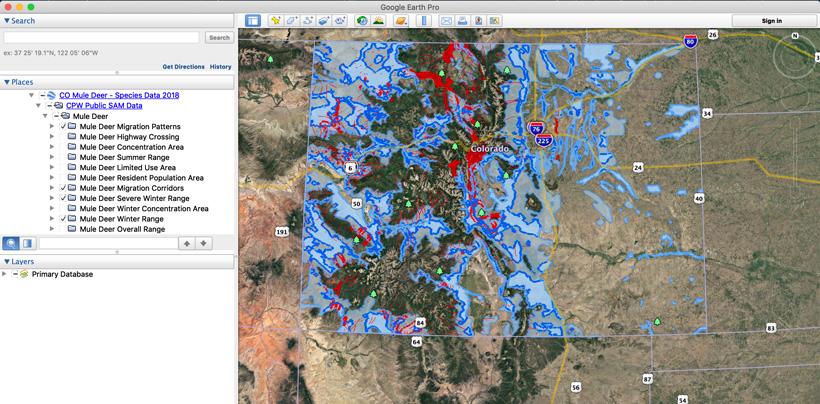
Screenshot of migration layers loaded on Google Earth.
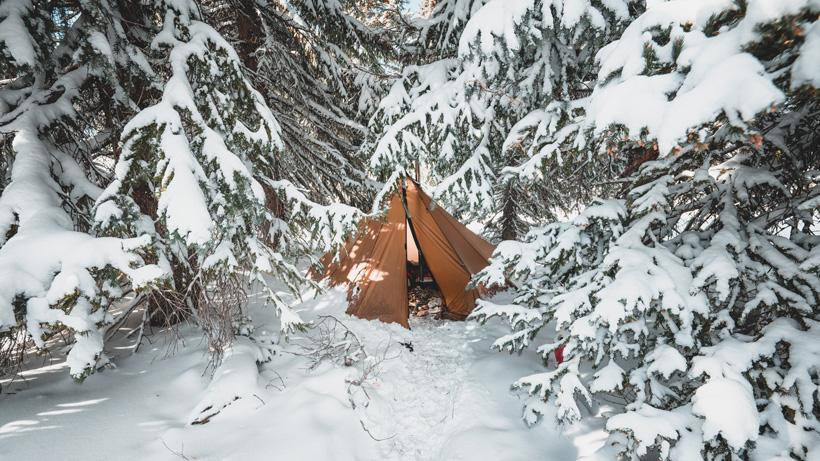
If you missed Part One of this mule deer scouting series, I suggest you check out that article first. Much of the information covered here expands on some of the techniques discussed in the first article. This article will be waiting for your return. You can read Part One here.
After our last discussion, now we are going to start fine-tuning what we should be looking for when it comes to summer scouting for fall mule deer hunts. We are going to focus on finding fall buck habitat, migration corridors, and much more.
What we are looking for throughout our summer mule deer scouting efforts, is how to transform a vast mountain range, into several smaller areas that we can effectively hunt come fall. We need to focus on the areas that will actually hold deer in October or the first few weeks of November. A lot of this will come down to learning how to read mule deer country. The main goal here is that we don't want to waste our time staring over “pristine-looking country” in the fall that doesn’t hold any deer.
Another plus to summer scouting and why this type of scouting intel is essential is because you can’t always trust what you see while scouting out a unit on a map. The terrain is always steeper in real life, and sometimes it’s hard to pinpoint what type of vegetation you are looking on satellite images. I will say this though, GOHUNT's Insider research tools plus GOHUNT Maps, and toss in boots on the ground scouting... all of that equals success. You can significantly gain a leg up on the competition, through the use of scouting from your computer, but as always, nothing beats boots on the ground. One thing to note about summer scouting for fall hunts is not to get discouraged if summer scouting areas seem too thick to glass into for deer. Those spots will open up in the fall when the leaves have fallen, making things way more accessible to glass.
That fantastic looking summer country, while it holds some great velvet hunts, for the most part, it doesn’t hold deer in the fall. So we need to focus our efforts elsewhere while we are scouting during the summer months.
A lot of the terrain we are looking for when summer scouting for fall hunts is that pine, oak brush to aspen transitional zone. Usually this is anywhere from 7,000 to 9,000 ft (depending on what state). Extra attention should be given to the aspen and mountain browse ranges (Gambel oak or more commonly called scrub oak or oak brush). Dark timber and burns are also highly productive areas.
Transitional zones are areas that hold deer in between their summer range, and winter range, this zone is typically located directly above a pinyon-juniper zone. In terms of the types of vegetation, a transitional range is comprised of gambel oak, mountain shrub, and ponderosa pine along with mountain mahogany and aspens. One thing to keep in mind, during a mild fall and especially mild winters, mule deer could still be in the transitional range at higher elevations. Which follows some of my late-season strategies of hunting higher than most people during the later parts of the season. The transitional zone could be a holding spot for bucks in October or the first week of November. In my opinion, areas around the transitional zones are vital places to focus on when hunting that early to mid-November time frame.
Pines that are mixed with aspens and within proximity to sagebrush and sometimes oak brush are always areas that excite me and will get a mark on my GPS for a closer look come fall. Those pines are essential for extra security. When all that is mixed near each other you have some of my favorite type of mule deer country. Keep in mind that depending on the part of the state you have a tag for, or even the state you are hunting, this can vary. Also remember, no matter what state or season you are hunting, you still need to play out the core components of mule deer habitat which is food, water and cover. Find those three things, and you’ll find the deer. Cover/protection is one of the items I try to focus on locating. If the terrain is too open, you won't find the big bucks for the most part on these public land hunts. I tend to avoid places that are very open, as these are also places that “look too good to be true.” A buck might move through this open terrain during the rut, but chances of him slipping through the open country during fall is slim to none. Instead, I will try to find fingers of timber, aspens, or pinyon-juniper. Bucks really enjoy food sources that are in close proximity to cover due to the increased amount of pressure they get during hunting seasons.
Also, I like to pay close attention to figuring out the sagebrush, bitterbrush and pinyon-juniper zone in the area I'm hunting. Based on numerous mule deer studies, a vast majority of mule deer utilize pinyon-juniper, big sagebrush and bitterbrush on their winter ranges. This information could significantly come into play if you have a hunt that goes into the middle or later parts of November.
When it comes to early to mid-November hunts such as Colorado’s 3rd or 4th seasons, I feel it’s very valuable to start thinking about what types of habitats they will be moving into. Habitats buck move into can vary a lot across the west, but typically the kind of terrain we should concern ourselves with is big sagebrush parks mixed with aspens, and oak brush (7,000 to 9,000 feet), and mid-elevation pinyon and juniper stands that are mixed with sagebrush (5,000 to 7,500 feet). Some studies in Wyoming note that 74% of the crucial winter range occurs between 4,593 to 5,577 feet.
Summer scouting is excellent for figuring out the vegetation in person. If you look at the image above, you wouldn't know that there is a lot of feed in those back mountains. But when it's covered in snow, it looks like all rocks.
It takes a few years to figure out where and what terrain types bucks tend to prefer during a specific time of the year across the West. But you can cut your learning curve down.
Various types of mule deer zones:
The above zones are just a basic summary. Keep in mind that where you are in the West, these elevation zones will greatly vary.
Once you gather all the pieces of this puzzle, you’ll be ready for anything the deer or the mountain will throw at you. You’ll know that if mature bucks are not in their migration zones, you’ll find them higher up in their transitional zones just below their summer range. If you have weather on the way, you’ll know you want to move to the migration zone quickly and the flipside can be said if you get an unseasonably warm fall, the bucks will be in their summer range. All of these different scenarios should pop up in your head when you're summer scouting. It can't help to get all your Plan A through Z spots dialed for different weather patterns. By utilizing these steps, you will start to figure out areas you can glass from during your fall hunt. Keep in mind, what looks like a good opening on a ridge to glass from on GOHUNT Maps, most likely is choked with small trees making glassing nearly impossible. But this is why you are out summer scouting.
Keep in mind, no matter what state you’re hunting or what particular unit you’re in, mature bucks will tend to prefer a specific terrain or vegetation depending on the time of year… it is your job to figure that out. Once you figure that out, it’s game on!
By the time your hunt opens in the fall, one of the most significant changes to buck activity will be the types of forage bucks will be consuming, and as the fall gets further along, you also need to be considered with the what groceries the does are consuming as well.
According to multiple studies, mule deer have often been considered browsers (eat primarily shrubs as opposed to grazers which eat grasses and forbs) due to them commonly being observed for research studies in the winter. However, mule deer are actually opportunistic feeders that select the best food during that available growing season and time of the year. As summer vegetation dries up, mule deer begin to replace their typical summer forb diet. When frost starts to hit mule deer country, deer will shift to feeding predominantly on shrubby vegetation (Mule Deer, A Handbook for Utah Hunters and Landowners is one of my favorite books of all time). What I’m looking for when summer scouting is trying to figure out the habitat that will hold bucks.
This is where cover and feed during the later part of the season comes into play. Bucks love the edge habitats as they can feed and be within close proximity to cover.
Part of your summer scouting efforts can be spent crossing out non-huntable areas. Getting rid of some areas that don’t look productive means you’re not wasting your time hunting those less than ideal locations during the fall that will not be productive for mature mule deer. This is probably one of the most challenging and intimidating factors to hunting a new unit. You never know to an exact science where mature bucks will be, but in time, you can learn vital pieces to the puzzle that will help you narrow down the search.
One of the problems with determining a hunting spot is that plenty of areas might look great on a map, but not actually hold any deer. In my mind, I find that crossing off areas is extremely valuable. Which is why I’m not afraid to cross areas off that map. This task becomes a lot easier if you can hunt this location year after year or have hunted a similar time of year in another state. If you've hunted a different state or unit, you can take what you've learned and apply it to new hunting locations. Soon enough, you will see a pattern on what areas are way more productive than others.
But since we are just learning the unit, we need to be mobile in our summer scouting and check out the entire unit if possible.
What could be non-huntable areas?
To set yourself up for success in the fall, you need to look for hard to access places. These are the spots that a mule deer buck will feel safe while avoiding pressure (more on this on a later article). Think of it another way, by the end of October, in some states, a mature mule deer has already been hunted or impacted by hunts for other species, for almost 60 days. Seclusion to a mature buck can mean many things, it could be the distance from a road or trail, amount of dark timber, and living in or above steep terrain are all ways a buck will try to avoid you. The common factor here is bucks (more so big bucks) are not hanging out where there are other hunters. Finding the right cover for their security will be essential.
Bucks become hard to find and are timbered up until the rut begins. This is where some summer scouting can come into play by locating areas where bucks might move to. These could be dark timber patches within close proximity to quality feed, or steep and nasty ravines.
Locate areas in the summer that hunters might overlook. The less hunting pressure, the more bucks you'll find. If less hunting pressure means backpacking in, then, by all means, you should check out areas that other hunters aren’t willing to reach. On the flip side, less pressure could mean hunting lower elevations of the unit too.
Let’s face it. You just drove a bunch of miles for a weekend summer scouting trip and you’re itching to lay eyes on deer. But instead of hiking deep into the backcountry to scout, you can do a lot of great long-distance glassing near roads, or within a short hike to a great vantage point.
There is one tough part about this, laying eyes on a great buck and trusting he will still be nearby when your hunt arrives. It’s August or early September and you found a great buck hanging out at 10,000 ft while scouting. Will that buck still be there for a mid to late October hunt? Most likely you could find this buck on your hunt during October, as a good buck is most likely holding up in the aspens or dark timber. If there’s been little to average amount of snowpack in the high country before your hunt, I’m confident in saying that you could still find this buck where you located him. Those aspens will pull and hold deer during October.
One example of this was on my second season Colorado hunt in 2017. There was a giant snowstorm the day before the season opened that dumped roughly 1.5 feet of snow. I went high up in the mountains where this herd summers, and still found lots of bucks and deer tracks even higher. A few days after the storm, the deer were starting to pull off this area slightly, so I relocated my camp and we ended up killing two bucks right around 10,000 ft in late October. So even with the storm, these bucks were still tucked up near where they spend their summer months. They were just now a lot harder to find as they had switched over from lounging around in the open to now hanging out in the dark timber.
In summary, the quick and easy answer is you could start your hunt where you saw the buck during the summer and work down. Your buck could be close by, it just might take some glassing and patience to uncover him. I don’t like to make laying eyes on bucks my number one priority during summer scouting for fall hunts.
Since you’re scouting in the summer for late-season hunts, you’ll need to be looking for areas that bucks migrate into for the rut and wintering areas. Figuring out a big buck or more specifically a herd’s migration route is the actual hot sauce of hunting some of these late-fall hunts. If you leave this fact behind, you are setting yourself up for a long hunt as most of the bucks you’re looking for might be long gone. Bucks migrate for a number of reasons and are either calendar-based, weather-based, or rut based.
Also, if you’re hunting a season that could have a little bit of rut in the air, then finding the does will eventually lead you to the bucks. As the does start their annual trek out of the high country in search of better groceries, bucks will eventually begin to follow. This again is where it plays to have a basic understanding of mule deer biology and it would be wise to again revisit what types of vegetation they prefer this time of year.
I’ve always had this theory about bucks and herds of mule deer in general, will not fully migrate out of the high country at the first sign of severe weather if they still have all of their nutritional requirements. Too often I’ve heard hunters not having success because they think all of the bucks have migrated out of the high country already, and so they hunt low country with all the other hunters. Yes, some might migrate, but I’ve had great success bucking this trend on late October hunts and even early November hunts. I’ve also taken my biggest bucks to date by hunting in unconventional places. For the most part, according to mule deer studies, the timing of mule deer migrations to lower elevations is based upon quality forage, depth of snow, energy to get around in the snow, temperature, and possibly the age of the animal.
Some of that work is actually already done for you by state agencies. A quick Google search will give you links to download these maps/layers from certain state agencies. Take for example the state of Colorado, once you download these layers, this state will actually break them down by Severe Winter Range, Winter Concentration Area, and Winter Range layers. Keep in mind these layers are general purpose maps, and shouldn’t be used as a definitive guide to where deer will be. But are great reference points on where deer could be if the weather conditions push deer down. As mentioned in the fall food section, you’ll want to focus your attention on oak brush, aspen groves, and the fringes of habitat near dark timber.
No matter what unit you’re hunting, it’s always important to figure out if your unit is migration dependant. In some units, no matter the level of summer scouting you do, you will not find many deer or no deer at all. These units are heavily dependant on migrations. This is where these summer scouting for fall hunts techniques will come into play as knowing these migrations patterns are key to helping you figure out where you need to concentrate your efforts if you have a late fall hunt.
Questions we need to be answered when scouting or even hunting the unit:
While hunting during the fall, just like on summer alpine-type mule deer hunts, if I’ve found that doe, fawn, and young buck “nursery,”... point your optics higher to find the mature bucks. Focus on the habitats that will concentrate bucks during the season you’re hunting. Keep in mind that from year to year, certain things can change. If you find a pattern that works in one unit, definitely try it out in another unit or state, but understand you may have to modify your plan. Also during the summer, you can also take note of potential migration areas by checking for old deer sign, trails, rubs, and even deer scat.
Another big plus to summer scouting for fall hunts is getting to know where you can camp. There’s nothing worse than taking a truck and trailer up a long, windy mountain road in the fall, with no real camp spot, and having to back all the way down. I've been there, and I've done that.
When you’re planning for a fall hunt, you need to ask yourself several questions:
If you don’t have the extra time to take two days before your hunt and scout, then summer scouting is essential! If you think you’ll learn the unit while you hunt, you risk losing valuable hunting time and increase the chance of getting frustrated and rushing things (giving up on a spot too early).
Think of it this way, are you actually able to take additional days off of work and away from family to add on two days of scouting right before your hunt? For the majority of us, this isn’t possible. But it’s probably easier to take of some additional time in the summer for a quick scouting trip. Let’s say you have a 2nd season Colorado mule deer tag. That season is nine days long. If you are driving from out of state and took five work-week days off. That would mean the majority of Friday night and Saturday are travel days. That leaves you with six days for a hunt at best. Do you really want to burn up those precious hunting days trying to learn the unit you've never stepped foot in quickly? If you can take additional days off, then I highly recommend doing that. If you can’t make a trip out of state to scout during the summer, then, by all means, planning a few extra days before your hunt opens will be highly advantageous. You can still use some of the steps in this article to put yourself ahead of the curve.
I know several people who arrived for their early November hunt in a unit they had never stepped foot in before, and left after several days of hunting and drove home. They were getting burned out aimlessly moving around the unit trying to figure it out and find a good buck. That frustration in my mind was due to not devoting specific time to scout the unit, and like I’ve said before… you can effectively summer scout for a late fall hunt! If that isn’t the type of hunt you want, some summer scouting could be just the ticket. After all, setting yourself up for success is all about the little things.
If your hunting season is already open and longer than a week, you could head out and add on a few days to hunt and do some of these tactics and “scout” with a weapon in your hand. It's not ideal, but this strategy can work.
Anything you can do now to learn your hunting unit or mule deer behavior is better than just going into your hunt blind. The great part about summer scouting for fall hunts is that once you’ve hunted certain places, you can take the knowledge and experience you’ve gained and apply that to future hunts. With all of this intel gained so far in your summer scouting efforts, you should have also found some great glassing points and have marked those down along the way.
Summary of items:
Also, luck could be on your side, and while scouting for your hunt in the summer, you might run into some generous locals who are willing to give you some intel or show you some areas on a map.
Summer scouting, for the most part, doesn’t take a ton of real work, it just takes some planning at home to mark some spots on a map, and then double and triple-checking them while in the field. Scouting days, are so much more valuable than hunting days. In the end, summer scouting for fall hunts is all about getting to know the lay of the land. If you only can drive around the unit for two days, that is two days that you are head by the time your hunt comes up. Plus, any time spent in the mountains looking over mule deer country is time well spent.
Again, if you haven't read part one of this summer mule deer scouting for fall hunts, you can check out the article through the link below:
Summer alpine zone - 10,000 to 13,000 feet
Subalpine zone - 9,000 to 11,000 feet
Dark timber, pine and aspen - 7,000 - 11,500 feet
Transitional zone - 6,000 to 9,000 feet
Sagebrush winter range zone 4,000 to 7,000 feet
Areas near heavily used campgrounds
Locations in close proximity to a trailhead
Spots with lots of ATV trails
Hillsides that are too open
What triggers the migration of mule deer in your unit? Weather, seasonality?
When the deer migrate, do they all push to private? Why is that?
Is there actually any public land habitat in your unit that will hold deer when they push out of the high country? Or is that ideal habitat all on private?
Pressure… how does it impact deer movement in your unit? Will the bucks move to another unit or to private land? More on that in my next article about “hunting the hunters.”
Do you want to set up a comfortable basecamp and then leave from their every day?
Will you leave from camp on foot or with a vehicle?
Do you have the means to backpack in and camp if necessary?
Do you prefer a hotel?
What towns might have better accommodations for the hunt you’re looking for?
Do you have access to horses or mules?
Don’t focus on your need to find bucks. We don’t need to see bucks, just sign they were there.
Think in the future… where will the bucks be in mid-October? Where will they be in late October or early November?
Learn what type of terrain is most beneficial to bucks for the time you're hunting.
Have you hunted this time frame before for a different species? Can you recall where you saw bucks? If so, use that to your advantage.
If you have a November hunt, I can’t stress the importance of figuring out how the habitat in your unit will dictate how your November hunt will. For example, a lot of the best rut/winter habitat in most areas of the West are on private land. By the time some of the later rifle seasons come along, bucks are already unhuntable due to private land having the best habitat. Once they hit those giant private ranches, for the most part, they are safe. So when you are researching for a unit to apply for, or even trying to figure out where to hunt, you need to take note of the habitat for that season.
Are you able to bring extra gear for this? Chains, etc.
What type of conditions can your truck get you through?
Will you bring an ATV? Is an ATV essential or make it safer?
If so, how far is that hotel from your hunting locations?
Is your hotel location limiting your hunting efforts because the hotel is a 1.5-hour drive one way to your main hunt location?